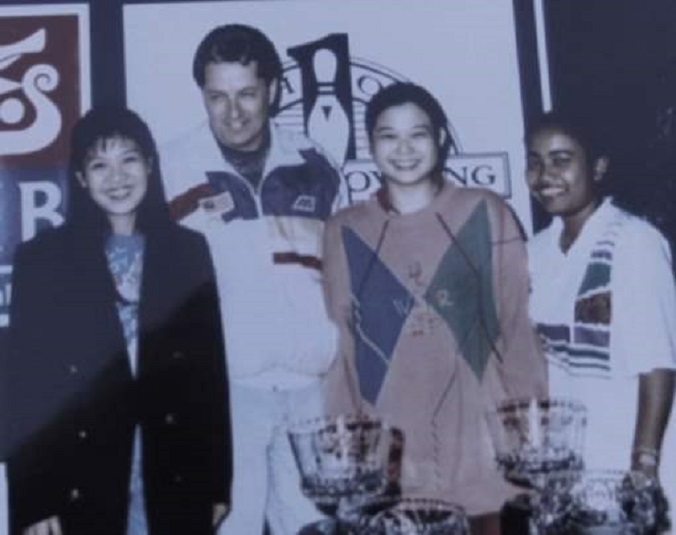 Canadian Sid Allen, Malaysian bowling coach for a decade (1990-2000), who has been accredited to Malaysia’s rise as a powerhouse in the world arena of the sports, knows Shalin Zulkifli better than anyone.
Canadian Sid Allen, Malaysian bowling coach for a decade (1990-2000), who has been accredited to Malaysia’s rise as a powerhouse in the world arena of the sports, knows Shalin Zulkifli better than anyone.
Allen, who was handpicked by Malaysian Tenpin Bowling Congress president, Datuk Dr P. S, Nathan (a former national bowler himself), was responsible for designing and implementation of an eight-year-old development programme and a four-year advancement programme besides being involved with the national adult and youth teams over the decade.
Allen, who turned 72 on December 12, is a highly respected bowling coach in the world bowling fraternity and was indeed a loss to Malaysia when he had to severe ties with Malaysia in the most unpleasant circumstances.
A good number of the very same Malaysian bowlers whom he had nursed and groomed over a decade to make a name for themselves in the international bowling scene, revolted against him and wanted him out.
Suddenly, they all felt that he was not good enough to “take them to the next level.”
Naturally hurt, Sid parted ways, though amicably with MTBC, especially Dr Nathan.
But Malaysia’s loss was the gain of Singapore, Hong Kong, and Indonesia in this region, while others who benefited include Latvia, England, and Catalonia besides the world of bowling itself as the World Tenpin Bowling Association roving coach.
Presently, Allen is based in Singapore for the last 15 years as a consultant but has been appointed Technical Director, for the last three years.
I have known Allen since he came to Malaysia and have kept in touch all this while.
Below is an exclusive interview where Allen spoke his mind following Shalin’s announcement of retirement after her 28-year career last week.
‘Shalin legitimised young people to come and train at the bowling centres.
Prior to that, bowling was always associated with gambling and was therefore not considered an appropriate venue for young people.
When I first started coaching Shalin, she had no ball speed. As a member of the youth team that went to the World Youth in Caracas, Venezuela in 1992, her lack of ball speed was exposed on their dry lane condition.
Upon her return, she worked extremely hard on improving this skill set, to the point where it became her biggest asset.
When most people think of Shalin’s game, they think of her incredible ball speed.
 My fondest memory with her was coaching her in the 1997 AMF World Cup Finals during an outside step ladder final in front of the pyramids in Cairo, Egypt.
My fondest memory with her was coaching her in the 1997 AMF World Cup Finals during an outside step ladder final in front of the pyramids in Cairo, Egypt.
Bowling on an elevated platform in the middle of the mid-day sun was an unforgettable experience. Photos of that event went around the world and onto unfamiliar newspaper pages, of which the greatest was a full-colour shot of the front page of the New York Times.
Her last major games success was in my opinion her greatest. It was the 2017 SEA Games in Malaysia.
Immediately after her step ladder win in the Masters, I had told her: “I have seen most of your best performances, but I think this has been your best”.
Her response was: “I think so too”.
I did a weeklong clinic in Malaysia a few years ago for around 100 coaches and players organised by MTBC. At the end of the clinic, as we were cleaning up, Shalin made the effort to put right what happened during the end of my time in Malaysia. It was a moment that meant a lot to both of us.
Although Shalin will be remembered for many generations as the queen of Malaysian bowling, it would be wrong to not understand her influence around the world.

Her emotional body language is legendary, inspiring players worldwide to express their emotions and passion.
What makes her responses so inspirational is that its real, it comes from deep inside of her. As a coach I have asked all teams I coach to release as much emotion and noise as possible.
I believe it reduces the build-up of stress within the athlete, which allows the body to perform at an elite level. She is by far the greatest example of wearing your heart on your sleeve.
Shalin, leading the contingent at major games such as the Commonwealth Games has made bowlers around the world proud for 30 years.
Additionally, winning the World Bowler of the Year Award at 16 years old is used by coaches around the world as an example of age not being a barrier to the selection, which has given many young players opportunities to perform on National Teams at an early age.
The Malaysian Women’s Team will now be required to re-establish their brand now that Shalin has retired.
It will not be the same, she will be sorely missed by teammates and opponents alike. – By Tony Mariadass
DISCLAIMER: The views and opinions expressed in this article are solely those of the writers or contributors. These views and opinions do not necessarily represent those of www.sports247.my

































